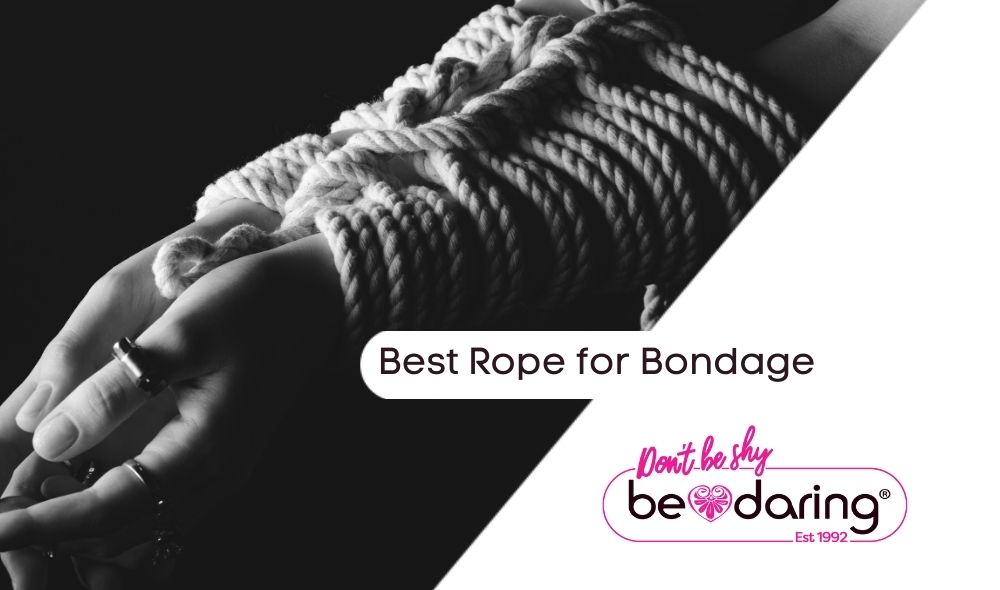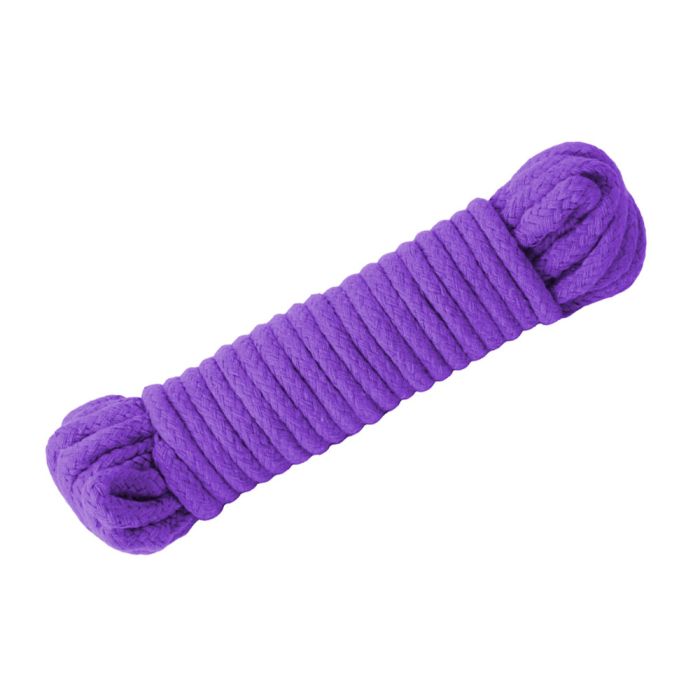Best rope for bondage

You only need rope to get started. However, rope comes in many distinct textures. Which rope is the finest for bondage?
Types of bondage rope available
If you visit any Shibari website or search for bondage movies on YouTube, you will see that most individuals use light, sand-colored rope approximately the thickness of your little finger.
Most likely, they are utilising jute or hemp rope. These are natural ropes created with natural fibres. While not expressly designed for bondage or usage as rope restraints, they are popular because to their feel, strength, and ease of handling. But that isn’t the only type of rope you can use for bondage. You can also use cotton rope, nylon rope or polypropylene rope.
The benefits of each rope material type
Here are some things to keep in mind when looking for Shibari rope.
Cotton bondage rope
Cotton is a natural fibre rope, like jute and hemp. Cotton rope, on the other hand, is readily available and manufactured on a regular basis, unlike the other two materials. Cotton rope is now plentiful and inexpensively accessible at a variety of locations. Cotton rope is supple and silky, and it feels great against the skin. However, because of its construction, it is prone to stretching, and the ends might fray or get extended with wear. So, while you'd never see a professional Shibari master use cotton rope, it's ideal for beginners owing to its low cost and wide range of hues.
Hemp and Jute bondage rope
What the professionals utilise. These ropes are typically only available in one hue (natural brown), but they look amazing in images. Hemp and jute ropes are sturdier than cotton ropes, yet still flexible enough to bind. They are rougher against the skin than cotton rope, but still supple enough to be pleasant. BDSM knots tied with cotton rope can become extremely tight and difficult to unravel. Hemp and jute ropes require significantly more strain to condense the knots tightly enough to be unpicked. The disadvantage of natural fibre ropes like these is their high cost. They cost significantly more than man-made ropes. The other disadvantage of natural rope is shedding. As you work with it, small strands of fibre shed, ending up in the air and on your clothing. Some people may be allergic to natural fibre rope.
Polypropylene webbing (climbing rope)
Climbing rope is smooth and slippery, which makes it easy to work with. It is both easy to undo and quite sturdy. Because of the low friction, you are less likely to have rope burn, but knots may not hold well and it may slip on your skin. It's also reasonably priced, so unless you already have any, I recommend going with hemp or jute.
Treating bondage rope
If you buy natural fibre rope, such as jute or hemp, you should be aware that it comes in three varieties.
- Untreated bondage rope. The rope is delivered "as is," with no treatment applied after weaving. Natural hemp and untreated jute have a hard feel to them, with several small strands of material hanging off them. The rope is strong, and while it isn't very scratchy, it isn't silky smooth either. It has a rough texture. However, after use, the fibre strands shed, allowing the rope to become more supple and useful.
- The bondage rope has been dry treated. Dry treating rope involves rubbing natural rope with oil or wax. This treatment technique is occasionally carried out by rubbing an oil-soaked towel over the ropes. The rope feels smoother and silkier after this treatment. It slides better over the skin and can help you tie BDSM knots. It is also less likely to shed on your floors and clothing! Keep in mind that if you work with rope frequently, it will naturally dry up since the oil from your hands and the person being tied permeates into it.
- Wet-treated bondage rope. During the wet treatment process, the bondage rope is drenched in water and hung to dry under tension. You can clean your ropes by washing them in hot water (this is known as wet treatment). If you fail to dry them under tension, you will wind up with a rope that is unsuitable for Shibari, which is why most people prefer dry treatment if they do it themselves at home.
When you buy rope from a specialist source, you will typically be given the option of purchasing it natural or treated. What you should choose depends on your unique preferences. Just keep in mind that treating the ropes will cost more, and you can do it yourself.
If you buy untreated rope, keep in mind that it would be best to cure it. Without treatment, the friction from the strands rubbing against one other would cause the rope to deteriorate and finally break, necessitating the purchase of new rope. Therefore, you might be better off paying to buy treated rope from the outset, and learning how to dry treat your rope every once in a while to keep it feeling and looking great.
Bondage rope length and diameter
Another choice you have to make is what diameter and length of rope to buy. Bondage rope comes in different mm thicknesses. If you run out of rope during a tie, you can easily lengthen it by adding another one to it. It appears a little sloppy because there may be a knot where it shouldn't be, spoiling the overall design. As long as you set the knot so that it is not painful for your rope bottom, it makes no functional difference other than appearance.
Rope bondage safety
Rope bondage is deadly if done wrong, thus no rope bondage guide for beginners would be complete without discussing safety.
When tying, always consider safety first and attempt to reduce the risk to your submissive.
What makes rope bondage unsafe?
The primary risks of rope bondage are:
Nerve injury. Nerve injury happens when a rope is too tightly wound around a nerve, crushing it. The longer the nerve is crushed, the more damage it will sustain. Nerve injury symptoms include numbness or diminished sensation in the nerve-supplied area; acute, agonising, or searing pain; pins and needles sensations; muscle weakness; and the sensation that a hand or foot has 'gone asleep'. Nerve injury can be brief, resolving in a few minutes, or permanent, never fully healing or needing months to heal.
Circulation loss. If a rope is tied too tightly, it might block off blood flow to some regions of the body. The body is rather tough, and it can withstand a cessation of circulation for roughly an hour without sustaining any permanent damage. However, it is advisable to avoid it altogether. Falling can cause head injuries. If a person trips while their hands are tied, they have no way of breaking the fall. Similarly, standing with their ankles bound increases their chances of tripping and injuring themselves.
Joint injuries. If a knot is tied poorly and there is a lot of force on the rope, or if it is jerked rapidly, the joints may be displaced. One example is the Strappado, in which the arms are bound behind the back and the individual is suspended by them. Left in this position, the shoulders will dislocate. Shoulders are likely the most vulnerable joints when practicing Shibari, however all joints should be watched.
Strangulation. An obvious one. Tying around the neck is an absolute no-no. Don't do it under any circumstances. However, strangulation can occur if ropes wrapped over the shoulders slip upwards by unintentionally.
Unable to communicate. If your submissive is bound and gagged, she will be unable to say the safeword or communicate with you if she is uncomfortable and wishes to halt the activity.
Subspace. Submissives may enter subspace, making it impossible to converse. Learn the indications of subspace and remember to observe your partner at all times.
















